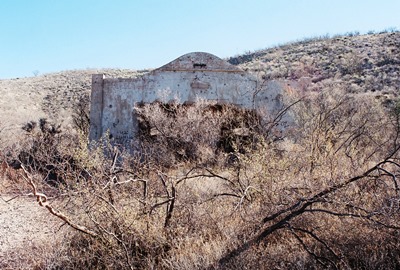
Traveling southwestward down the dusty Ghost Town Trail puts us in the town of Courtland, a ghost if ever there was one. You won’t find the odd holdout or hermit here. There is no one for miles around in this slice of the southeastern corner of the Dragoon Mountains; only the remains of a couple buildings, the most interesting and intact being the old jail, shown above.
Named after Courtland Young, part owner of the Great Western Mining Company, Courtland, Arizona was actually established by his brother, W.J., in 1909. The post office opened quickly, on March 13 of that year. The area was considered to be one of the most promising for copper in the state and soon other mining operators entered the fray, including the Calumet & Arizona, Copper Queen, and Leadville Companies. Within a couple months, 8,000 feet of underground shaft was in place.
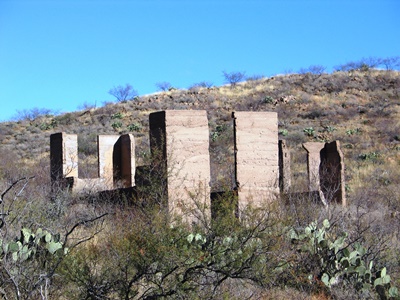
The population eventually reached 2,000 and there were the usual amenities, including saloons, hotels (the “Courtland” and “Great Western” being the most popular), restaurants, and stage stations. The newspaper, the Courtland Arizonan, started printing almost immediately. But there were some unusual things for the time in Courtland, including an automobile dealership, ice cream parlor, movie theater, baseball field, and horse track. Water was also rather unusual in this part of the world and, in 1911, five miles of water main were laid by the Courtland Water and Ice Company for those who didn't drink only whiskey. All this is gone now. Nearly.
For a while Courtland had no jail. Prisoners were held in an old mining tunnel until an unhappy inmate tried to burn the door down by lighting his mattress on fire. The prisoner survived, probably only to languish a bit more in the slammer, and also prompted the construction of a sturdier facility. It must’ve been sturdy indeed, because it is the only feature in Courtland that is not mostly rubble. It also has a twin, in nearby Gleeson. We’ll visit there next.
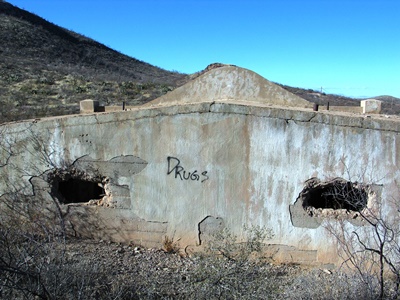
Courtland, like the surrounding area, felt the effects of Pancho Villa and his men as they raided north of the Mexican border until 1916, when General "Black Jack" Pershing pushed them back south for good.
Just before 1920, it became apparent that the copper ore was running out. Tests showed that a limestone bed lay at about 300 feet below the surface. By 1920, mining operations were actually beginning to lose money. The newspaper shut down, and the writing was then clearly on the wall. People fled Courtland en masse. The post office didn’t close until 1942 though. One wonders who was posting letters.
(The photo below shows a store which, when Philip Varney visited in the 1970's, still possessed a front on which faint lettering could be made out. Not anymore!)
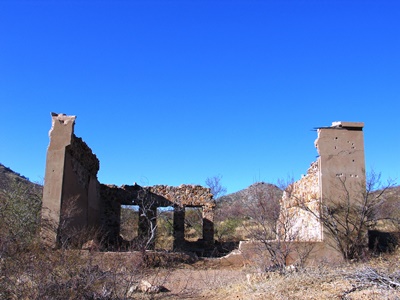
One person who didn't need the post office was Big Nose Kate’s former husband, George M. Cummings, an Irish blacksmith who spent some time in Courtland after Kate divorced him around 1900 for being an abusive drunk. He apparently didn’t think too highly of himself either and committed suicide with a shotgun in Courtland in 1915. “Head cancer” was reportedly one of the causes.
As with our previously featured town, Pearce, Arizona Ghost Town Trails provided the best background on Courtland. Of course, Philip Varney’s account was interesting, too.
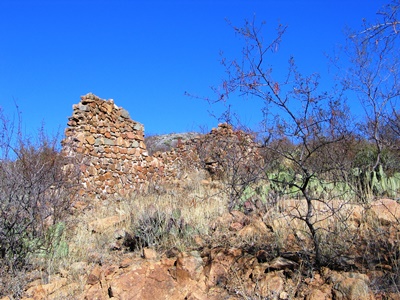
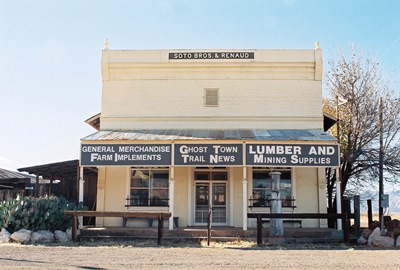
Pearce, Arizona marks the beginning of the Ghost Town Trail. Start heading southwest out of town down the gravel road that goes past Courtland and Gleeson and eventually drops you off in Tombstone and you will find yourself in some very desolate territory. No doubt you’ll encounter someone from Homeland Security, who will laugh at you for wanting to travel over something like thirty miles of rutted dirt with perhaps a few drug runners scattered about in the hills. But all that will come later, as Pearce itself is still occupied by a few folks and is a rather well-kempt little cluster of buildings. It must feel much as it would’ve in the late 1800’s.
Pearce is named for Cornishman James (Jimmie) Pearce, a rancher and hard rock miner from Tombstone who accidentally found gold AND silver while horseback riding in 1894. Jimmie immediately staked a claim, opening the Commonwealth Mine in Fittsburg, a mile east, said to be one of the richest mines ever worked in the state, producing over 15 million dollars in gold. Thus was born Pearce, the last of the Arizona gold rush towns.
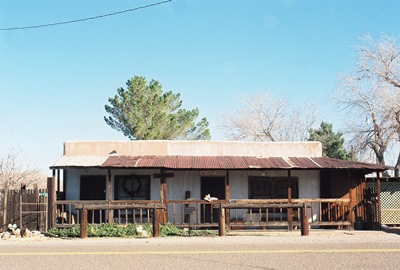
The Pearce family quickly lost their enthusiasm for mining though and before long had sold to John Brockman for $250,000 and a boarding house for Mrs. Pearce to run. The agreement was that Brockman had nine months to mine enough precious metal to cover the cost of purchase or everything, including what Brockman mined, would revert to the Pearce’s. In the end, Brockman covered his payment in six months with gold to spare. Apparently everyone was happy with the deal. Mining then peaked quickly, in 1896, around the time the post office (shown above) arrived and the population really boomed, many people moving their entire homes from Tombstone.
Brockman’s operation suffered a few annoying fires and he sold in 1902. But a couple years before Brockman’s sale, Burt Alvord had turned from Pearce lawman to train robber and the infamous Alvord-Stiles gang set-up in town. However, the gang was mostly dead or in jail by the time the railroad finally arrived in 1903. Before that, to deter theft from folks like Burt Alvord and Billy Stiles, gold coming out of the mine was made into bars too heavy to be transported by horseback alone and taken down the road to Cochise by wagon.

By 1919, 1,500 people lived in Pearce. There was a movie theater, hotels, saloons…the works. But, by the 1930’s, the Commonwealth Mine was played out, the Great Depression was in full swing and almost everyone packed up and left, including the railroad, which took its track with it.
There are a number of very cool old structures remaining in Pearce. Perhaps most striking is the old general store, shown at the top of this post, built by Soto Bros. & Renaud in 1896 out of adobe, wood, stucco and decorative tin. I’ve read that there are many interesting artifacts inside, but when I tried to have a look there was no one around. In fact, the building appears to be for sale,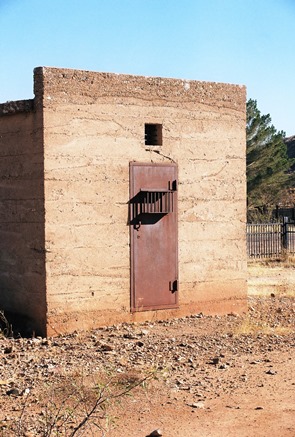 so who knows what the future holds? The post office, just across the street, is a private residence. To the north are two jails: The “old” jail, which has reached such a state that even the least devious among us could easily break out, and the “new” jail, shown here, which was built in 1915 and used until around the time the mine closed in the 1930’s. The “new” jail is constructed of 10” thick poured concrete walls reinforced with rebar and contains two cells. The doors are iron and the only ventilation is through tiny windows at the top. During a summer’s day in southern Arizona this would be a most unpleasant place to find one’s self.
so who knows what the future holds? The post office, just across the street, is a private residence. To the north are two jails: The “old” jail, which has reached such a state that even the least devious among us could easily break out, and the “new” jail, shown here, which was built in 1915 and used until around the time the mine closed in the 1930’s. The “new” jail is constructed of 10” thick poured concrete walls reinforced with rebar and contains two cells. The doors are iron and the only ventilation is through tiny windows at the top. During a summer’s day in southern Arizona this would be a most unpleasant place to find one’s self.
The best and most concise resource on Pearce is probably Arizona Ghost Town Trails. There is some more history and photos of both jails at ghosttowns.com. You can learn a little more about Burt Alvord and his gang HERE. As usual, initial inspiration and direction came from Mr. Philip Varney.
So, of course, we’re going to head down the lonely Ghost Town Trail. Next we’ll have a look at Courtland, AZ.
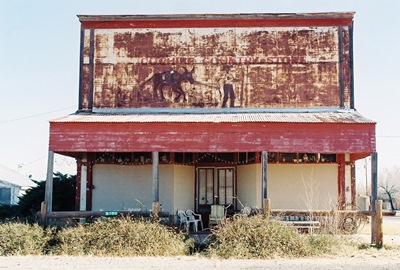
We’ve gotta make a quick stop in Cochise, Arizona. It’s in southeastern Arizona, just below I-10, and, while now quite small, it’s not really a ghost town. However, it has a couple great, old buildings and some real Wild West history. In its heyday, Cochise sat at the junction of the Southern Pacific and Arizona Eastern railroads, which serviced the many mining towns nearby.
The Cochise Country Store, shown at top and below, was built in 1913 and open until probably fairly recently. It fronts what used to be the railroad stop and folks could step right off the train into the sweltering Arizona heat and get something to eat and drink. Now the trains just whistle right on by.
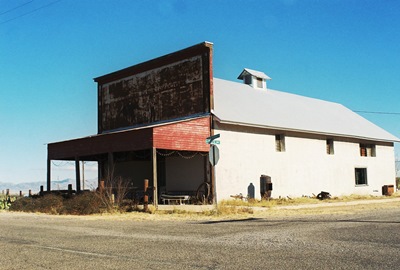
Directly across the street and similarly oriented is the Cochise Hotel, listed on the National Register of Historic Places in 1976. Opened in 1882, guests could still spend the night until July 2007. That’s 125 years of continuous service. The hotel was built by John Rath, a railroad telegrapher, who ran it with his wife, Lulu.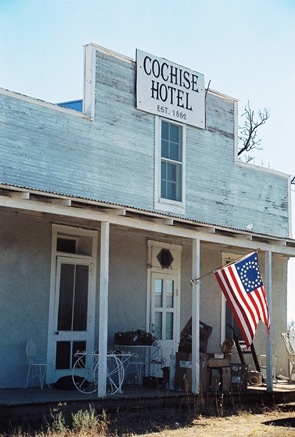 It also served as a telegraph office, naturally, as well as a Wells Fargo office and mail stop. In 1980, after mentioning the Green Cattle Company Safe in the old office, the harness house out back, and the sofa in the parlor rumored to have once belonged to the Swedish Nightingale, opera singer Jenny Lind, Philip Varney wrote in Arizona’s Best Ghost Towns, “Quite simply, the Cochise Hotel is one of the most interesting buildings in the West.” Of course, in typical fashion, I showed up years too late to see most it. It's clearly still well-cared for, but when I was there cardboard boxes were sitting on the porch waiting to be moved…somewhere. Whether any Wild West treasures were inside I can't say.
It also served as a telegraph office, naturally, as well as a Wells Fargo office and mail stop. In 1980, after mentioning the Green Cattle Company Safe in the old office, the harness house out back, and the sofa in the parlor rumored to have once belonged to the Swedish Nightingale, opera singer Jenny Lind, Philip Varney wrote in Arizona’s Best Ghost Towns, “Quite simply, the Cochise Hotel is one of the most interesting buildings in the West.” Of course, in typical fashion, I showed up years too late to see most it. It's clearly still well-cared for, but when I was there cardboard boxes were sitting on the porch waiting to be moved…somewhere. Whether any Wild West treasures were inside I can't say.
The Cochise Hotel is where Big Nose Kate came to work for a year or so around 1899 or 1900, years after her common-law husband, Doc Holliday, had died, and shortly after her wedded husband, George Cummings, had finally pushed his alcoholic abuse too far. He would later shoot himself in the nearby ghost town of Courtland (just wait, we’ll get there). Apparently guests at the Cochise were never privy to the identity of their (in)famous host.
By most accounts, Big Nose Kate was a prostitute in her early days, but she spent the last of her 90 years writing letters to her long-time friend, Arizona Governor George Hunt, giving him a piece of her mind about various goings-on at the Arizona state legislature. There may or may not be a lesson there but I believe you’ll be running some risks if you try to learn it firsthand.
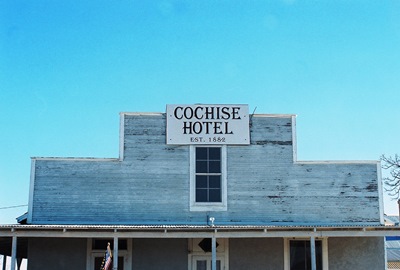
Kate said that she watched the Gunfight at the O.K. Corral from Doc Holliday's room at Fly’s Boarding House. That has been disputed, but she may well have been in Tombstone, where she'd operated a bordello, on that fateful late-October afternoon in 1881. She claimed Doc Holliday sat at the foot of his bed afterward, weeping. “That was awful," he reportedly told her. "Just awful."
Next time it’ll be down the road south just apiece, to Pearce, AZ, and the start of the Ghost Town Trail.
Information for this post came largely from Philip Varney and the Wikipedia entry for the Cochise Hotel with Texas Escapes filling in the details on Mary Katherine Horony aka Big Nose Kate.








 so who knows what the future holds? The post office, just across the street, is a private residence. To the north are two jails: The “old” jail, which has reached such a state that even the least devious among us could easily break out, and the “new” jail, shown here, which was built in 1915 and used until around the time the mine closed in the 1930’s. The “new” jail is constructed of 10” thick poured concrete walls reinforced with rebar and contains two cells. The doors are iron and the only ventilation is through tiny windows at the top. During a summer’s day in southern Arizona this would be a most unpleasant place to find one’s self.
so who knows what the future holds? The post office, just across the street, is a private residence. To the north are two jails: The “old” jail, which has reached such a state that even the least devious among us could easily break out, and the “new” jail, shown here, which was built in 1915 and used until around the time the mine closed in the 1930’s. The “new” jail is constructed of 10” thick poured concrete walls reinforced with rebar and contains two cells. The doors are iron and the only ventilation is through tiny windows at the top. During a summer’s day in southern Arizona this would be a most unpleasant place to find one’s self.

 It also served as a telegraph office, naturally, as well as a Wells Fargo office and mail stop. In 1980, after mentioning the Green Cattle Company Safe in the old office, the harness house out back, and the sofa in the parlor rumored to have once belonged to the Swedish Nightingale, opera singer
It also served as a telegraph office, naturally, as well as a Wells Fargo office and mail stop. In 1980, after mentioning the Green Cattle Company Safe in the old office, the harness house out back, and the sofa in the parlor rumored to have once belonged to the Swedish Nightingale, opera singer 